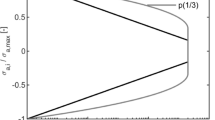The nuclear power plant equipment is subjected to in-service cyclic loading, and the stress variation amplitude usually exceeds twice the yield strength of the material. In the case of elastic analysis, strain is underestimated. A simplified elastoplastic fatigue analysis is included in NPP design codes. It is based on the design fatigue curve using the plastic strain correction factor (Ke) to refine stresses by elastic analysis, followed by the fatigue one. Different stress origins determine mechanical and thermal plastic strain correction factors to be used for the stresses induced by mechanical and thermal loadings, respectively. Fatigue analysis was performed with different plastic strain correction factors. The total stress calculations give correct results by employing the mechanical plastic strain correction factor, especially in the case of thermal stress predominance, the analysis result is too conservative. In engineering practice, the correction factors can be used for refining stresses induced by mechanical and thermal loadings.

Similar content being viewed by others
References
Boiler and Pressure Vessel Code, Section III, ASME (2004).
RCC-M: Editon 2000 and Addendum 2002, AFCEN (2002).
P. G. J. Hodge, Plastic Analysis of Structures, McGraw-Hill Book Co., Inc., New York (1959).
M. W. Lu, “Foundation of plasticity for design by analysis of pressure vessels,” Pres. Ves. Technol., 31, No. 1, 20–26 (2014).
J. Shen, “Plastic correction of simplified elastic-plastic analysis method in ASMEVIII-2,” Chem. Eng. Mach., 41, No. 1, 65–68 (2014).
Y. Zhou, S. Bao, J. Dong, et al., “Advances in design by analysis’ methods for pressure vessels,” J. Tsinghua Univ., 46, No. 6, 886–892 (2006).
H. Hubel, Simplified Elastic-Plastic Fatigue Analysis of Smooth Structure, European Commission, Spain (1995).
G. C. Slagis, “Meaning of Ke in design-by-analysis fatigue evaluation,” J. Pres. Ves. Technol., 128, No. 1, 8–16 (2006).
D. Moulin and R. L. Roche, “Correction of the Poisson effect in the elastic analysis of low cycle fatigue,” Int. J. Pres. Ves. Pip., 19, No. 3, 213–233 (1985).
B. F. Langer, “Design-stress basic for pressure vessels,” Exp. Mech., 11, No. 1, 1–11 (1971).
J. Du, X. J. Shao, Q. H. Kan, et al., “Calculation strategy for the determination of plasticity correction factors,” Key Eng. Mater., 725, 345–350 (2016).
J. P. Prost and F. Arnaudeau, “Elastic plastic strain correction factor in stainless steel pipes and nozzles subjected to thermal shocks,” in: Proc. of the 4th ICPVT (1980), pp. 80–90.
J. M. Grandemange, J. Heliot, and J. Vagner, “Improvements on fatigue analysis methods for the design of nuclear components subjected to the French RCC-M code,” ICPVT, No. 6, 350–356 (1998).
X. J. Shao, L. P. Zhang, et al, “Research on elastoplastic strain correction factor of titanium alloy,” Nucl. Power Eng., 34, No. 3, 148–151 (2013).
ANSYS User’s Manual for Version 13.0, ANSYS Inc. (2013).
Author information
Authors and Affiliations
Corresponding author
Additional information
Translated from Problemy Prochnosti, No. 1, pp. 182 – 187, January – February, 2021.
Rights and permissions
About this article
Cite this article
Fu, X.L., Zhang, L.P., Tian, J. et al. Plastic Strain Correction in Fatigue Analysis of Nuclear Power Plant Equipment. Strength Mater 53, 183–188 (2021). https://doi.org/10.1007/s11223-021-00274-2
Received:
Published:
Issue Date:
DOI: https://doi.org/10.1007/s11223-021-00274-2




